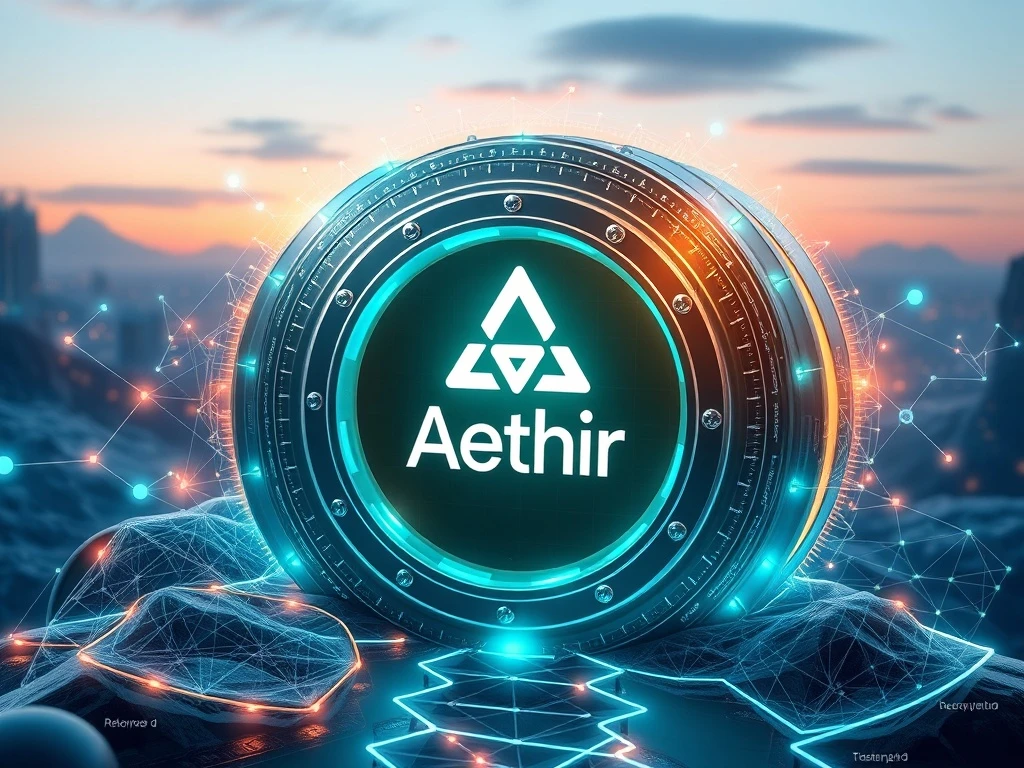Groundbreaking DePIN Strategy: Nasdaq’s Predictive Oncology Unleashes $344M Aethir Digital Asset Treasury

A significant shift is underway in the corporate world, particularly for those closely following the convergence of traditional finance and blockchain innovation. Nasdaq-listed Predictive Oncology, a biotechnology company, has announced a groundbreaking move, establishing a $344.4 million digital asset treasury centered on Aethir’s ATH token. This marks a pivotal moment, as it represents the first time a Nasdaq company will actively manage tokens from a Decentralized Physical Infrastructure Network (DePIN). This bold step signals a new era for publicly traded firms exploring the vast potential of decentralized technologies and their underlying assets.
Predictive Oncology Pioneers a New DePIN Investment Model
Predictive Oncology (POAI), a biotechnology firm specializing in AI-driven cancer research, recently unveiled its substantial digital asset treasury. This treasury, valued at $344.4 million, focuses on the ATH token from Aethir. This strategic decision positions POAI as a pioneer among Nasdaq-listed entities directly engaging with decentralized physical infrastructure networks. Furthermore, this initiative showcases a novel approach to corporate treasury management.
The company developed this innovative capital strategy with expert guidance from DNA Fund, a prominent Web3 investment and advisory firm. BTIG also played a crucial role, serving as the placement agent for the transaction. Predictive Oncology disclosed these details recently, highlighting the collaborative effort behind this venture.
Understanding the Hybrid Financing Structure
The financing model for Predictive Oncology’s DePIN treasury is particularly noteworthy. It was structured through two concurrent private placements in public equity (PIPEs). This dual-pronged approach included:
- Cash Investment: A traditional cash infusion from investors.
- Crypto PIPE: In-kind contributions of ATH tokens, directly integrating digital assets into the company’s financial structure.
This hybrid model allows Predictive Oncology to record tokenized DePIN infrastructure directly as a balance sheet asset. Consequently, it creates a unique connection between conventional equity markets and cutting-edge decentralized computing networks. The ATH treasury will be intrinsically linked to Aethir’s decentralized GPU infrastructure, ensuring a tangible connection to real-world utility.
Aethir’s Role in the Decentralized Physical Infrastructure Network Landscape
Aethir stands at the forefront of the DePIN market, offering a decentralized cloud network that provides crucial GPU infrastructure. This infrastructure supports a wide array of demanding applications, including:
- Artificial Intelligence (AI)
- High-Performance Computing (HPC)
- Advanced Gaming Applications
The network leverages blockchain technology to efficiently coordinate and distribute access to physical compute resources. This innovative approach solidifies Aethir’s position as a vital participant in the rapidly expanding DePIN sector. Its native asset, ATH, currently trades at under $0.06, boasting a market capitalization of approximately $2.3 billion, according to CoinMarketCap. Notably, ATH’s 24-hour trading volume surged by over 330% following the Predictive Oncology treasury announcement, reflecting significant market interest.
Predictive Oncology’s Stock Soars on Digital Asset Treasury News
Predictive Oncology’s strategic pivot into decentralized infrastructure immediately captured investor attention. Shares of POAI surged over 70% on Monday, the day the digital asset treasury announcement broke. This rally propelled the stock to its highest valuation since March, indicating strong market approval for the company’s new direction. This significant uplift demonstrates how a clear, innovative strategy can revitalize a company’s market perception.
Before this announcement, Predictive Oncology had spent the previous two years trading as a penny stock. The company faced challenges, including limited revenue and a consistent history of quarterly losses. For example, it reported only $2,682 in revenue for the second quarter of 2025 and $110,310 in the first quarter, alongside net losses exceeding $2 million in each period. In its most recent quarter, POAI raised approximately $586,000 through an at-the-market offering to help fund operations. This new strategy, featuring a substantial Aethir holding, provides a fresh narrative and potential for growth.
The Growing Trend: Nasdaq Company Embraces Crypto Assets
Predictive Oncology’s new strategy places it among an expanding cohort of small-cap and microcap firms adopting digital asset treasury models. This trend signifies a broader acceptance of crypto assets within traditional corporate finance. In July, for instance, the former biotech company 180 Life Sciences rebranded as ETHZilla. It then announced ambitious plans to accumulate Ether (ETH) as a primary treasury asset. This rebranding highlights a clear commitment to digital assets.
Other publicly traded companies are making similar moves to integrate crypto assets onto their balance sheets. These include:
- Mill City Ventures (MCVT)
- Nature’s Miracle (NMHI)
- Upexi (UPXI)
- Helius Medical Technologies (HSDT)
- AVAX One (formerly AgriFORCE Growing Systems)
While this trend gains momentum, analysts at Standard Chartered have issued a word of caution. They suggest that digital asset treasury companies might face a valuation squeeze. This potential squeeze could occur as market net asset values (mNAVs), which compare a company’s enterprise value to its crypto holdings, continue to decline. Standard Chartered’s analysis indicates increasing market saturation as a primary driver for recent mNAV compression. This underscores the importance of strategic asset management and careful market timing for any Nasdaq company venturing into this space.
The Future of Corporate Treasuries and DePIN Integration
The decision by Predictive Oncology to establish a $344 million DePIN treasury, focusing on Aethir, represents a landmark event. It not only diversifies the company’s assets but also legitimizes decentralized physical infrastructure networks in the eyes of traditional finance. This pioneering step by a Nasdaq company could inspire many others to explore similar models. The integration of digital assets into corporate balance sheets offers new avenues for capital generation and strategic growth. However, companies must navigate the inherent volatility and evolving regulatory landscape of the crypto market. As the digital asset space matures, we can expect further innovations in how traditional businesses interact with blockchain technology and its transformative potential.







